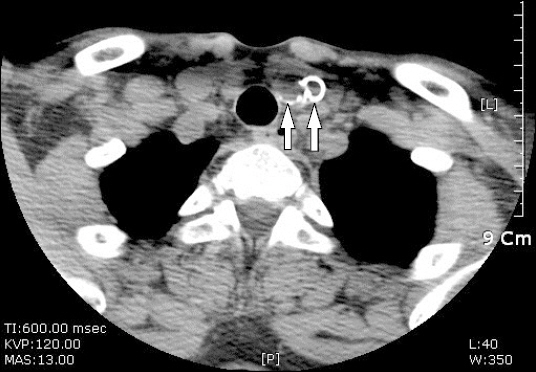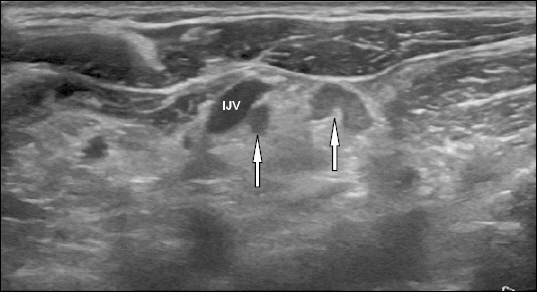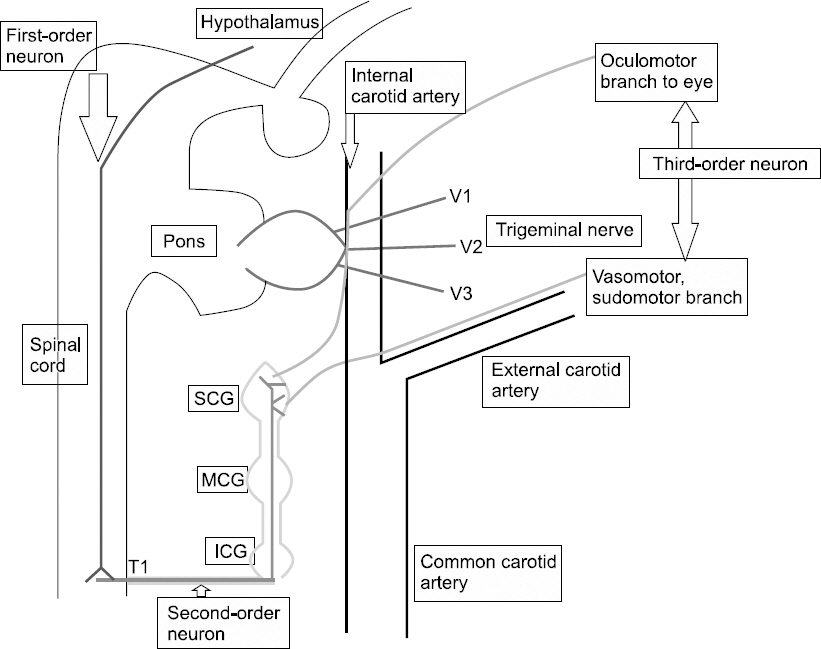Anesth Pain Med.
2016 Jul;11(3):313-317. 10.17085/apm.2016.11.3.313.
Painful Horner syndrome after thyroidectomy: A case report
- Affiliations
-
- 1Department of Anesthesiology and Pain Medicine, Kwangju Christian Hospital, Gwangju, Korea. d013804@naver.com
- KMID: 2344938
- DOI: http://doi.org/10.17085/apm.2016.11.3.313
Abstract
- Horner syndrome is characterized by miosis, partial blepharoptosis and anhidrosis on the affected side of the face. This syndrome develops when the oculosympathetic nerve pathways to the eye and face are interrupted by various causes such as tumor in the brain, intrathoracic region or neck, surgery, drugs, trauma, carotid artery dissection, and others. It is referred to as painful Horner syndrome when Horner syndrome is accompanied by hemifacial pain. Pain is probably related to trigeminal nerve injury. Horner syndrome is a rare complication of thyroidectomy. Here, we report the case of a patient who experienced ipsilateral painful Horner syndrome after total thyroidectomy and unilateral neck dissection for thyroid cancer.
Keyword
MeSH Terms
Figure
Reference
-
1. Abbas A, Manjila S, Singh M, Belle V, Chandar K, Miller JP. Johann Friedrich Horner and the Repeated Discovery of Oculosympathoparesis: Whose Syndrome Is It? Neurosurgery. 2015; 77:486–91. DOI: 10.1227/NEU.0000000000000832. PMID: 26280826.2. Torpiano P, Borg E, Cassar PJ, Manche’ A. Intrathoracic schwannoma with Horner syndrome. BMJ Case Rep. 2013:2013; bcr2013201247.
Article3. Ying X, Dandan G, Bin C. Postoperative Horner’s syndrome after video-assisted thyroidectomy: a report of two cases. World J Surg Oncol. 2013; 11:315. DOI: 10.1186/1477-7819-11-315. PMID: 24378178. PMCID: PMC4029459.
Article4. Ma H, Kim I. Horner Syndrome associated with a Herniated Cervical Disc: A Case Report. Korean J Spine. 2012; 9:108–10. DOI: 10.14245/kjs.2012.9.2.108. PMID: 25983798. PMCID: PMC4432357.
Article5. Civelek E, Karasu A, Cansever T, Hepgul K, Kiris T, Sabanci A, et al. Surgical anatomy of the cervical sympathetic trunk during anterolateral approach to cervical spine. Eur Spine J. 2008; 17:991–5. DOI: 10.1007/s00586-008-0696-8. PMID: 18548289. PMCID: PMC2518767.
Article6. Leuchter I, Becker M, Mickel R, Dulguerov P. Horner’s syndrome and thyroid neoplasms. ORL J Otorhinolaryngol Relat Spec. 2002; 64:49–52. DOI: 10.1159/000049270. PMID: 11891400.
Article7. Salengros JC, Jacquot C, Hesbois A, Vandesteene A, Engelman E, Pandin P. Delayed Horner’s syndrome during a continuous infraclavicular brachial plexus block. J Clin Anesth. 2007; 19:57–9. DOI: 10.1016/j.jclinane.2006.05.020. PMID: 17321929.
Article8. Reddy G, Coombes A, Hubbard AD. Horner’s syndrome following internal jugular vein cannulation. Intensive Care Med. 1998; 24:194–6. DOI: 10.1007/s001340050546. PMID: 9539082.
Article9. Nautiyal A, Singh S, DiSalle M, O’Sullivan J. Painful Horner syndrome as a harbinger of silent carotid dissection. PLoS Med. 2005; 2:e19. DOI: 10.1371/journal.pmed.0020019. PMID: 15696206. PMCID: PMC545208.
Article10. Salvesen R. Raeder’s syndrome. Cephalalgia. 1999; 19(Suppl 25):42–5. DOI: 10.1177/0333102499019S2511. PMID: 10668120.11. Morís G, Ribacoba R, Solar DN, Vidal JA. Dolichoectasia of the cavernous internal carotid artery: another cause for Raeder’s syndrome. J Headache Pain. 2000; 2:123–5. DOI: 10.1007/s101940070053. PMCID: PMC3611777.
Article12. Biousse V, Touboul PJ, D’Anglejan-Chatillon J, Lévy C, Schaison M, Bousser MG. Ophthalmologic manifestations of internal carotid artery dissection. Am J Ophthalmol. 1998; 126:565–77. DOI: 10.1016/S0002-9394(98)00136-6.13. Kim SY, Kim YH, Yang SW, Moon DE. Persistent ptosis following stellate ganglion block with local anesthetic : A case report. Anesth Pain Med. 2009; 4:87–90.14. Lee YS, Nam KH, Chung WY, Chang HS, Park CS. Postoperative complications of thyroid cancer in a single center experience. J Korean Med Sci. 2010; 25:541–5. DOI: 10.3346/jkms.2010.25.4.541. PMID: 20357995. PMCID: PMC2844597.
Article15. Meng K, Tian W, Lv Z, Song X. Horner’s syndrome subsequent to minimally invasive video-assisted thyroidectomy in two patients. Oncol Lett. 2015; 10:459–62. DOI: 10.3892/ol.2015.3159.
Article
- Full Text Links
- Actions
-
Cited
- CITED
-
- Close
- Share
- Similar articles
-
- Iatrogenic Horner’s Syndrome Developing after Robot-assisted Transaxillary Total Thyroidectomy
- Unilateral Horner's Syndrome following supraclavicular brachial plexus block
- Prolonged Horner's Syndrome following Stellate Ganglion Block: A case report
- Contralateral Horner's Syndrme after Stellate Ganglion Block: A case report
- Prolonged Horner's Syndrome Following Interscalene Brachial Plexus Block: A case report




